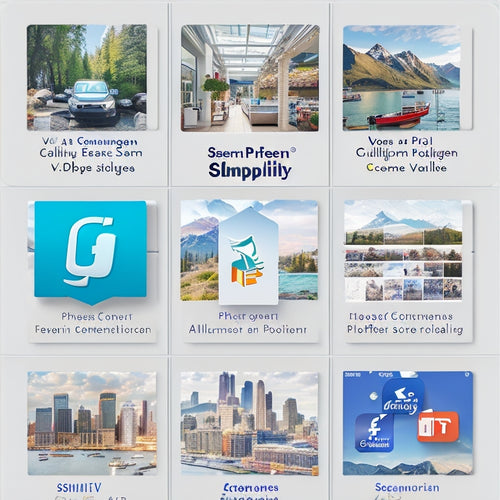
What's Holding Your Online Store Back From Scaling?
Share
You're pouring over performance reports, wondering why your online store's growth has stagnated despite your best efforts. It's likely due to one (or more) of several common obstacles. You might be lacking clear business goals, resulting in reactive decisions and wasted resources. Inefficient order fulfillment systems could be costing you 10-15% of sales revenue. Perhaps your website's poor user experience is driving customers away, or limited product offerings are stifling growth. Outdated technology infrastructure, inadequate supply chain management, and insufficient customer support could also be holding you back. Identify and address these issues to reveal your online store's full potential – and discover more strategies to get you there.
Key Takeaways
• Lack of clear business goals leads to reactive actions, wasted resources, and stagnant growth, hindering online store scaling.
• Operational inefficiencies, such as poor order fulfillment and supply chain management, result in lost sales and decreased customer satisfaction.
• A subpar website user experience, limited product offerings, and ineffective marketing strategies struggle to convert visitors into customers, limiting online store growth.
• Inadequate customer support and high cart abandonment rates negatively impact revenue and customer loyalty, making it difficult to scale an online store.
• Outdated technology infrastructure, insufficient server capacity, and outdated software stacks hinder online store efficiency, scalability, and security, causing growth stagnation.
Lack of Clear Business Goals
Without clear business goals, you're likely to find yourself stuck in a cycle of reactively putting out fires rather than proactively driving growth and scaling your online store.
This lack of direction can lead to wasted resources, decreased productivity, and a stagnant bottom line.
To break free from this cycle, you need to establish a solid foundation of strategic planning and goal setting.
This means defining what success looks like for your online store and creating a roadmap to get there.
Inefficient Order Fulfillment Systems
Fulfilling orders inefficiently can cost you an average of 10-15% of your sales revenue, and it's likely that you're losing even more in customer satisfaction and loyalty. This is a significant blow to your business, especially when you're trying to scale.
You can't afford to waste resources on manual processes that slow down your order fulfillment. It's time to optimize your system.
You need to streamline your order tracking and inventory management processes. This means automating tasks, such as updating inventory levels and sending shipment notifications, to reduce errors and increase efficiency. With accurate order tracking, you can provide your customers with real-time updates, building trust and loyalty.
Poor Website User Experience
As you scale your online store, a poor website user experience can be a major roadblock to growth.
You're likely familiar with the frustration of a cluttered navigation bar, slow page loading times, and unclear call-to-actions that confuse customers and drive them away.
Cluttered Navigation Bar
When you cram too many items into your navigation bar, you risk overwhelming visitors and driving them away with a poor website user experience. You need to strike a balance between providing easy access to essential pages and avoiding clutter. A cluttered navigation bar can lead to a high bounce rate, especially on mobile devices where screen real estate is limited.
To optimize your navigation bar, consider the following best practices:
| Best Practice | Why It Matters |
|---|---|
| Design consistency | Maintains a cohesive look and feel across all devices and browsers |
| Mobile responsiveness | Ensures a smooth user experience on smaller screens |
| Product categorization | Aids customers in quickly finding what they're looking for |
| Search functionality | Permits customers to search for specific products or keywords |
Slow Page Loading Times
Your online store's sluggish page loading times are costing you sales, with every extra second of delay resulting in a 7% reduction in conversions. You're essentially discarding potential revenue with each passing second. The culprit? Unoptimized images and inefficient content delivery. It's time to take action.
Start by compressing your images using tools like TinyPNG or ImageOptim. This can decrease file sizes by up to 90%, leading to quicker load times.
Next, optimize your content delivery by leveraging a content delivery network (CDN). A CDN distributes your content across multiple servers, making sure that users access it from the nearest location, resulting in speedier page loads.
Don't underestimate the impact of slow page loading times on your bottom line. You've worked hard to drive traffic to your site – now it's time to make sure that users stay and convert. By focusing on image optimization and content delivery, you can boost conversions, increase user satisfaction, and ultimately, drive revenue growth.
The clock is ticking – it's time to speed up your online store.
Unclear Call-to-Actions
Now that you've addressed slow page loading times, it's time to shift your focus to another conversion-killing culprit: unclear call-to-actions (CTAs) that confuse and frustrate users, leading them to abandon their shopping carts.
You're likely losing sales due to CTAs that are poorly crafted, concealed, or ambiguous. In fact, according to a study, 70% of small business websites lack a distinct CTA. It's time to optimize your CTAs for enhanced customer engagement and conversion enhancement.
Start by making your CTAs prominent and transparent. Use action-driven language like 'Shop Now' or 'Get Started' and make sure they stand out from the rest of the content. Also, reduce resistance by minimizing the number of steps needed to finalize a purchase. A/B testing can assist you in identifying the most efficient CTAs and layouts.
Inadequate Supply Chain Management
How do you ensure that your online store's supply chain can keep up with rising demand, especially during peak sales periods or when faced with unexpected disruptions? Inadequate supply chain management can lead to stockouts, delays, and lost sales. To avoid this, you need to focus on building strong supplier relationships and optimizing your inventory.
Developing strong supplier relationships is important to guaranteeing a steady flow of products. You should regularly communicate with your suppliers to negotiate better prices, improve delivery times, and resolve any issues promptly. Consider implementing a supplier scorecard to track their performance and identify areas for improvement.
Inventory optimization is also vital to scaling your online store. You need to accurately forecast demand and adjust your inventory levels accordingly. Implementing an inventory management system can help you track your stock levels, identify slow-moving products, and automate reorder points. By optimizing your inventory, you can reduce stockouts, minimize waste, and free up working capital to invest in growth initiatives.
Limited Product Offerings Online
As your online store grows, recognizing that limited product offerings can constrain sales, hinder customer satisfaction, and ultimately stifle scalability is vital. You're likely leaving money on the table by not providing customers with the variety they crave. It's time to rethink your product strategy.
| Consequence | Solution |
|---|---|
| Limited customer choice | Expand product sourcing to include new suppliers or manufacturers, ensuring a diverse range of products. |
| Stagnant sales growth | Implement effective inventory management systems to track and optimize stock levels, reducing the risk of stockouts or overstocking. |
| Decreased customer loyalty | Conduct market research to identify gaps in your product offerings, and prioritize filling those gaps to meet customer demands. |
Ineffective Marketing Strategies
Frequently, online stores struggle to convert visitors into customers, and it's often due to ineffective marketing strategies that fail to resonate with their target audience. You might be throwing money at social media ads, but if you're not targeting the right demographics, you're wasting your budget.
It's time to reassess your marketing approach and focus on what drives real results. For instance, are you leveraging influencer partnerships to reach new customers? If not, you're missing out on a massive opportunity. According to a recent study, influencer marketing can generate up to 11 times the ROI of traditional advertising methods.
Take a closer look at your social media strategy. Are you creating content that speaks to your target audience's pain points? Are you using the right channels to reach them? It's time to get granular and optimize your marketing efforts.
Stop relying on guesswork and start using data to drive your decisions. Analyze your customer data, track your website analytics, and adjust your marketing strategy accordingly. By doing so, you'll be able to create a more effective marketing strategy that drives real results and helps your online store scale.
High Cart Abandonment Rates
High cart abandonment rates are quietly draining your online store's revenue, with a staggering 70% of customers ditching their carts before checkout, leaving you with a significant gap in potential sales. You're not alone - it's a universal pain point for e-commerce businesses. But it's time to take action.
You can start by streamlining your checkout process. Make it seamless, intuitive, and hassle-free. Reduce the number of form fields, implement auto-fill options, and provide clear shipping estimates. Your customers will thank you.
Next, reassess your payment options. Are you catering to diverse customer preferences? Offer a range of payment methods, including digital wallets, credit cards, and even cryptocurrencies. Don't force customers to abandon their carts due to limited payment choices.
Insufficient Customer Support
You're likely losing customers to competitors who offer better assistance, since 67% of online shoppers have switched to a different retailer due to poor customer service. This isn't surprising, given that 90% of customers rate customer support as 'very important' or 'important' when deciding whether to do business with a company.
| Support Type | Description |
|---|---|
| Reactive Support | Customers reach out to you with issues, and you respond. |
| Proactive Support | You anticipate and address customer concerns before they reach out. |
| Omnichannel Support | You provide seamless assistance across all channels (phone, email, chat, social media). |
To scale, you need to level up your customer assistance. Implement enhanced chatbots to provide personalized interactions and 24/7 availability. This will help you respond quickly to customer inquiries and reduce wait times. Additionally, invest in omnichannel assistance to ensure a consistent customer experience across all touchpoints. By doing so, you'll increase customer satisfaction, loyalty, and ultimately, drive more sales. It's time to prioritize customer assistance and give your customers the experience they deserve.
Outdated Technology Infrastructure
As you scale your online store, you're likely to encounter limitations with your current technology infrastructure. You might be using legacy systems that can't handle increased traffic, or servers that are struggling to keep up with demand.
It's time to assess whether your technology stack is holding you back, and identify areas where outdated software and infrastructure need to be upgraded or replaced.
Legacy System Limitations
Sixty-five percent of online stores still rely on outdated technology infrastructure, severely hampering their ability to scale efficiently. You're likely no exception, and it's hindering you from reaching your full potential. Legacy system limitations are a major obstacle to scaling your online store.
When you're stuck with outdated technology, system integration becomes a nightmare. You're forced to deal with disparate systems that don't communicate with each other, causing inefficiencies and errors.
Data migration is another significant challenge. You can't easily migrate your data to a new system without risking data loss or corruption. This means you're stuck with a system that's not designed to handle your growing business needs.
It's essential to acknowledge the limitations of your current technology infrastructure and take action. Start by identifying areas where your current system is holding you back. Then, develop a plan to migrate to a more modern, scalable system that can integrate seamlessly with other tools and platforms.
Don't let legacy system limitations hold you back any longer. It's time to take control of your online store's technology infrastructure and unleash your scaling potential.
Inadequate Server Capacity
Your online store's insufficient server capacity is a ticking time bomb, ready to crash under the weight of increased traffic and sales, and it's likely already costing you lost revenue and damaged customer relationships. As your business grows, your server capacity must expand to meet the demand. Failing to do so will result in slow load times, crashed sites, and frustrated customers.
| Server Capacity | Consequences |
|---|---|
| Insufficient | Slow load times, crashed sites, lost revenue |
| Inadequate Resource Allocation | Inefficient use of resources, poor performance |
| Inadequate Bandwidth Allocation | Congested network, slow data transfer |
To avoid these consequences, you must prioritize server optimization and scalability planning. This involves evaluating your current server capacity, identifying bottlenecks, and allocating resources effectively. By doing so, you'll ensure your online store can handle increased traffic and sales, providing a seamless customer experience and driving business growth. Don't wait until it's too late – take control of your server capacity today and start scaling your online store with confidence.
Outdated Software Stacks
Running on obsolete software stacks can quietly undermine your online store's performance, placing it at risk of security breaches, compatibility issues, and slow load times that push customers away.
You can't afford to disregard the impact of outdated technology infrastructure on your online store's scalability. Neglecting to implement software updates and technology upgrades can result in system crashes, data loss, and damage to your reputation.
Additionally, obsolete software stacks can impede system integrations, making it challenging to incorporate new tools and platforms, ultimately impacting your store's platform compatibility.
To avoid these setbacks, it's crucial to prioritize software updates and technology upgrades. Regularly assess your software stacks to pinpoint areas that require enhancement.
Invest in adaptable and scalable solutions that can adjust to your expanding business requirements. By doing so, you'll guarantee smooth system integrations, enhance platform compatibility, and ultimately, enhance your online store's performance and scalability.
Don't allow outdated software stacks to hinder you from reaching your business objectives. Take action today and safeguard the future of your online store's technology infrastructure.
Limited Cash Flow Management
As you navigate the challenges of online store scaling, managing limited cash flow becomes a critical component of your growth strategy, requiring you to prioritize expenses and make tough financial decisions daily. Without a solid grasp on your cash flow, you risk overspending, stockouts, or even bankruptcy. To avoid these pitfalls, you need to stay on top of your finances.
Effective cash flow management starts with accurate forecasting and tracking. You should be able to predict your inflows and outflows, identifying potential bottlenecks and opportunities for optimization. This is where expense tracking comes in, helping you allocate resources efficiently and cut unnecessary costs.
Here are some key strategies to keep in mind:
- Implement a rolling forecast to adjust to changing market conditions
- Set clear financial goals and KPIs to guide your decision-making
- Automate expense tracking to reduce errors and increase transparency
- Identify areas for cost reduction and negotiate with suppliers or vendors
Frequently Asked Questions
How Do I Determine the Root Cause of My Scaling Issues?
As you venture into the unknown, searching for answers, you're about to uncover the hidden saboteur holding your online empire back. Conduct a ruthless root cause analysis, pinpointing bottlenecks, and you'll finally identify the exact culprit strangling your growth.
What Metrics Should I Track to Measure Online Store Performance?
You should track key metrics like conversion rate, customer retention, and average order value to measure online store performance, identifying areas for improvement and optimizing your strategy for maximum growth and revenue.
Can I Scale My Online Store Without Sacrificing Profit Margins?
"When you're stuck between a rock and a hard place, you must optimize pricing strategies to maintain profit margins while investing in customer retention. Meanwhile, streamline inventory management to fuel customer acquisition and drive growth."
How Do I Balance Personalization With Automation in Customer Support?
You're striking a balance between personalization and automation in customer support by implementing efficient, data-driven processes that prioritize customer satisfaction, ensuring streamlined interactions that drive loyalty and revenue growth.
What Are the Most Common Scalability Mistakes New Entrepreneurs Make?
As you scale your online empire, beware of common pitfalls: you're likely to trip over poor hiring decisions, inventory management missteps, and inefficient systems, which can cripple your growth and leave you stuck in the slow lane.
Related Posts
-

What Integrations Does Shopify Have
This article aims to provide an overview of the integrations available on the Shopify platform. By exploring the ben...
-

Which SEO App Is Best for Shopify
This article aims to provide an objective analysis of the best SEO app for Shopify, catering to the needs of individ...
-

Top Shopify Form Builder Apps for 2022
This article provides an objective and analytical overview of the top Shopify form builder apps available in 2022. T...


